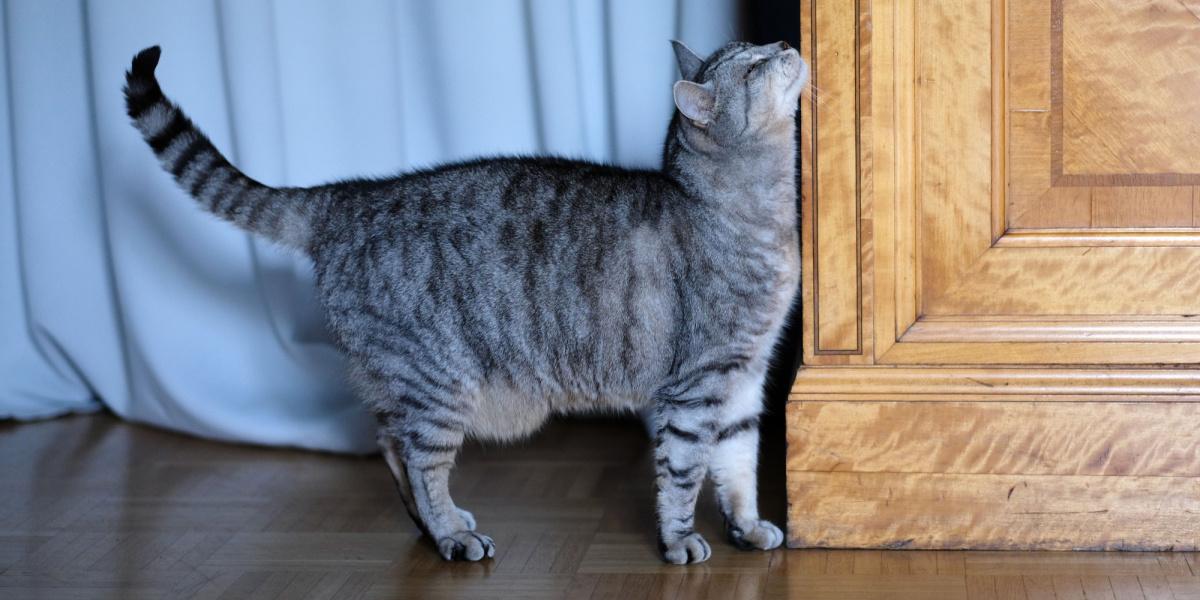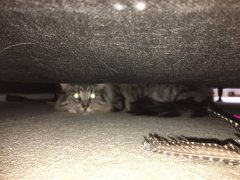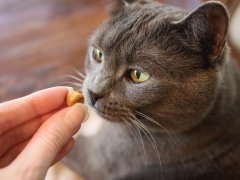
We love our cats for many reasons. They’re cuddly, entertaining, funny, adorable, and just amazing companions all around. One of the reasons that I love cats is that they still retain a wild streak from their ancestors and they share many traits with them.
A domesticated cat isn’t that different from a wildcat and cats in general have undergone very little domestication compared to other species. They have many similarities to the African wildcat, Felis silvestris lybica, and one of them, is that they’re territorial.
Cats are territorial animals and use spraying and marking as a way to claim their territory and warn other cats. Cats also mark territory by rubbing up against items, places, and people and leaving their scent. Domesticated cats can learn to live in multi-cat homes when they have plenty of resources for themselves and room to take space when needed.Key Takeaways
Are Cats Territorial?
One of the traits that cats have inherited from the wildcat is that they’re very territorial animals. Unlike dogs that tend to live together and enjoy other dogs’ company (for the most part), cats are often solitary pets and are fiercely independent. They mark and defend their territory in many ways and will fight to protect it if they need to.
This behavior stems from their ancestors, who lived alone and hunted to survive. They only mixed with other cats when they needed to reproduce or fight and avoided contact with them otherwise.
Although our cats have inherited these traits and behaviors from their ancestors, they can learn to live peacefully with other cats. We can see this in many households that have more than one cat (multi-cat households). There are a few things that facilitate this and if cats don’t have certain needs met this can cause their relationships to decline and fighting to start.
One of the main issues is that each cat has enough resources. Resources include food and water bowls, litter boxes (one per cat plus one), beds, hiding areas, and scratching posts. You need to have enough of these for the cats that you have and cats should have enough space to be away from each other if they wish. This reduces competition between cats and gives them less reason to resort to conflict.
It’s also important to have the cats neutered as unneutered cats are likely to be more territorial. Synthetic pheromones (Feliway) can also help to keep cats relaxed and feel secure in their home. Another method that cats use to help them feel secure and relaxed in their home, is scent marking and this is also how cats mark their territory. We’ll discuss this in more detail now.
How Do Cats Mark Their Territory?
Cats mark their territory to make themselves feel more secure in their environment and also to deter other cats from entering. Preventing other cats from entering may help to prevent physical fights.
Physical fighting in the wild would have been costly to cats because it causes injury. This may have prevented cats from hunting and would have been a sign of weakness. Fighting is a last resort for cats when it comes to protecting their territory. They try to avoid this by using a combination of scent marking and then body language and vocalizations when they see another cat.
Marking involves using scent to mark their territory. This scent will often contain pheromones, which act as chemical messages to other cats. Cats have a very specialized sense of smell and they detect these pheromones through their vomeronasal organ.
This is located behind their upper incisors. Pheromones in a scent mark can tell a cat a lot about the cat that left the mark. It can tell them how old the mark is and when the cat was last there, the gender of the cat and sexual availability, and where their territory is.
Cats mark with scent glands from their cheeks. In fact, you’ve probably seen this already. They do this by rubbing their cheeks against furniture, fence posts, and even us! They also have scent glands in their paws which they use when they scratch. Scratching is a really important cat behavior as it allows cats to deposit their scent and scratch marks act as a visual deterrent to other cats.
Another common way that cats mark territory is through their urine marking and feces. Cats will often spray urine around their territory and they may even do this indoors if they’re feeling stressed or threatened. Urine spraying is different from normal urination as it involves depositing small amounts of urine (but strong smelling) and is usually sprayed against vertical surfaces such as walls.
Feces contain scent and cats will often cover their feces to hide their scent and go unnoticed. However, if they’re trying to mark their territory and particularly if they’re feeling threatened, they may leave their feces uncovered around the borders of their territory as a warning to other cats. This is called middening.”
Do Female Cats Mark Their Territory?

Female cats also show marking behavior but in general, it is more common in male cats. In particular, unneutered male cats are the most territorial as they’re often fighting with other males for territory and females.
Male cats have a much higher concentration of hormones and pheromones in their urine than female cats. This is what accounts for the well-known “tom-cat smell.”
Territorial Aggression in Cats
As we’ve learned, cats prefer not to fight and will mark their territory in order to avoid it. Marking is a form of communication in cats that aims to avoid conflict. However, this doesn’t always work and despite obvious marked areas, cats will still enter another cat’s territory and threaten it.
Cats deal with conflict in a few ways. They first try to resolve the conflict through body language and vocalizations. Vocalizations are a common occurrence that I’m sure most of you have heard. Cats yowling, growling and hissing are common during a territorial spat.
They’ll display body language to scare the other cat off such as arching their back, puffing out their hair (piloerection), and staring. Cats often fight through “staring contests” with the losing cat looking away first. Even though these body language stances and vocalizations can appear very aggressive, they avoid physical contact between cats which we know they like to avoid if at all possible.
However, if cats can’t resolve their conflict through these initial stages, it may progress to a physical fight between the cats. This may involve scratching with their paws and biting each other. Cat bites can cause serious infection and pain. They may develop a ‘cat bite abscess’ which often needs veterinary treatment.
If two cats living in the same household are showing signs of aggression towards each other, you should seek the advice of a feline behaviorist. Ensure that each cat has enough resources and plug in a synthetic pheromone diffuser to reduce anxiety. Rule out medical issues such as urinary tract infections or urinary tract disease with your veterinarian if your cat is urinating inappropriately (inappropriate elimination).
Are Cats Territorial of Their Owners?
Cats are territorial pets and often direct their aggression toward other cats when they enter their territory. Their territory includes the area where they eat, sleep, and hunt. Cats will scent mark their home to make them feel more secure and they may even scent mark their owner. This is what is happening when cats rub against you. Cats don’t usually get protective or aggressive about their owners.
Normally, cats will direct their aggression toward other cats when they enter their territory. Occasionally cats can display redirected aggression toward their owners. This may occur if they see a cat entering their territory through a window and they can’t reach the cat. They may direct their frustration to the nearest person to them which may be their owner.
Final Thoughts

Cats are naturally territorial animals like their wildcat ancestors. They’re defensive of their territory which is the area where they sleep, eat, and hunt. Cats avoid physical fights at all costs and try to avoid this by marking their territory in order to deter other cats.
Cats mark their territory with scent glands from their cheeks and paws, along with urine (spraying) and feces (middening). If cats in the same household are displaying territorial aggression towards each other you should ensure that they have enough resources, plug in a synthetic pheromone diffuser, and seek advice from a feline behaviorist.
Also Read: Why Do Cats Bury Their Poop?
Frequently Asked Questions
Why is my cat marking territory?
Cats mark their territory to let other cats know that the area is theirs and to avoid conflicts with other cats.
Why do cats spray and mark?
Cats spray urine and mark their scent around their territory in order to convey this to other cats which can prevent physical fights and interactions.
What are the signs of territorial behavior in cats?
Cats are territorial animals and display this by marking their territory and fighting with unwelcome cats that enter their territory. They mark their territory with scent glands, urine and feces.
Do tomcats spray their territory?
All cats may spray their territory but tomcats are particularly prone as they’re unneutered males.






